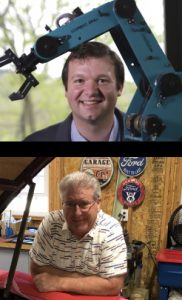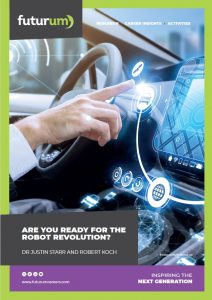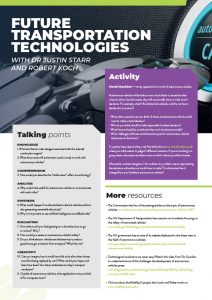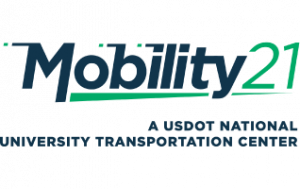Are you ready for the robot revolution?
Transportation is about to go electric and drive itself, meaning every car technician will need to understand how artificial intelligence works. Bringing us up to speed are Dr Justin Starr and Robert Koch, professors at the Community College of Allegheny County in the US.
TALK LIKE A ROBOTICS ENGINEER
Artificial intelligence (AI) — computer systems able to perform tasks normally requiring human intelligence
Autonomous vehicle — a vehicle that is able to drive itself without human input
Computer vision — AI software used to automatically interpret images; for example, to identify pedestrians on the road ahead
Mechatronics — technology combining electronics and mechanical engineering
For a hundred years, roads have been ruled by the internal combustion engine. By burning fossil fuels such as petrol and diesel, these engines have driven us into a bustling new age of highspeed transport. But there is a new revolution on its way.
Cruising into view is the electric car, and just around the corner, the self-driving bus. Climate change is pushing us to take cleaner and safer on-board technologies, and we all need to be ready. In particular, the technicians who service tomorrow’s vehicles need to understand how they work, and this is where Dr Justin Starr, Professor of Advanced Technology, and Robert Koch, Professor of Automotive Technology, come in. Based at the Community College of Allegheny County (CCAC) in Oakdale, Pennsylvania, Justin and Robert have been working to prepare the next generation of technicians for a computerised transport age.
Is it the end of the road for the internal combustion engine?
Currently, fossil-fuel driven cars are still the norm. However, Justin thinks we have reached an “inflection point” for surface transportation. We are yet to fully move towards electric vehicles, but the momentum is certainly heading that way. Not only that, “but the coming decades could see cars swapping human drivers for computerised ones,” adds Robert.
The problem for internal combustion engines is what comes out of their exhaust pipe and into the atmosphere – gases that are heating the planet and particles that are choking up people’s lungs. In the US, it is estimated that around a quarter of greenhouse gas emissions come from fossil fuel transport. One way of reducing these emissions and avoiding catastrophic climate change is to switch to electric vehicles, ensuring their batteries are charged with renewable electricity, such as wind or solar.
The other problem with today’s cars is that they crash too often. Usually due to human error behind the wheel, around 40,000 people are killed by road collisions every year in the US. Giving up the driver’s seat to robots could reduce this figure dramatically, although the technology to do so is yet to be perfected. For a robotics engineer like Justin, the approach of autonomous vehicles is an exciting prospect. The shift will affect everyone, though. “Transportation touches every part of our lives, so there is no opting out of this change,” he says. An understanding of autonomous vehicles will be required for anyone transporting themselves or goods from A to B, simply crossing the street, or planning their career.
What role will you play in the revolution?
As a young person today, you will not simply be looking on as these changes take place. In fact, your generation will be the one to shape the future of transport. Justin describes the coming decades as a rare opportunity for students to take part in a technological revolution.
“Autonomous vehicles are evolving as today’s students enter the workforce,” says Robert. “This gives them a unique opportunity to influence this emerging technology. Their interactions with autonomous systems – whether as drivers, technicians, researchers or consumers – will define an industry.” For example, the youngest engineers today grew up in the age of the internet, so they are used to thinking about interconnected systems and are forming ideas that older engineers would never think of. Furthermore, the next generation will need to decide how important privacy is. Will you be happy for your car to share your location with other vehicles and companies, or will you want this data to be anonymous?
How are autonomous vehicles “the new space programme”?
Big technological challenges lead to innovations that trickle their way down into society. For example, NASA’s programme of space exploration has contributed to a wide range of computing, imaging and material technologies. Justin thinks that the development of autonomous vehicles is playing a similar role.
By working towards safe driverless vehicles, the industry has developed new ultra-fast computer vision systems. Justin explains, “Pedestrian detection systems developed by autonomous vehicle companies are now a part of almost all internet-connected cameras, and the technology used to automatically read road signs is enabling apps to do ‘on-the-fly’ translation.”
Reference
https://doi.org/10.33424/FUTURUM365
(© Justin Starr and Robert Koch)
How do we get ready for robotic cars?
“When technology races ahead, education needs to keep pace,” says Robert. He and Justin are working to ensure that college students are prepared to work with self-driving cars and the components they contain. They do this by working with researchers who are part of a project called Mobility21. A collaboration between Carnegie Mellon University, the University of Pennsylvania and Ohio State University, Mobility21 is developing cutting edge technologies for a cleaner and more efficient transport system in the US.
Justin and Robert aim to incorporate the latest developments into college level teaching for vehicle technicians. For example, students now need to understand AI technologies, such as computer vision, in order to work with autonomous vehicles. “Self-driving car companies are looking for technicians who can work with software, so a basic understanding of programming, as well as electronics and mechanical systems, is now part of the required skill set,” says Justin.
Robert agrees that now is the time for students to develop the skills future technologies will require. “Training technicians on this technology now will allow them to gain a better understanding of systems as they evolve. This will improve ‘fix-it-right’ repairs down the road,” he explains.
Are we heading in the right direction?
The Mobility21 project has already had success in introducing AI to apprentice technicians. In one workshop, students learned the basics of self-driving cars through a simulation. In the simulation, they could train their own virtual vehicle to drive itself using AI in a virtual world, before racing each other. “Without any prior programming experience, our students were up and racing in just a few hours,” says Justin.
Justin and Robert feel programmes like this are helping to democratise the future of transportation – to make the technology accessible to all. Some people might think that AI is too complicated to understand without being an expert in mathematics or computer science, but this does not have to be the case. “With the right teaching tools, could get to grips with the concepts behind driverless cars,” says Robert.
In the future, Justin and Robert believe we will see AI technicians as skilled tradespeople, similar to electricians or carpenters. “We have shown that today’s community college students can absolutely be a part of these cutting-edge technological advances,” Justin says. “AI may teach cars to drive themselves, but it won’t teach them to fix themselves.”
 Dr Justin Starr
Dr Justin Starr
Endowed Professor of Advanced Technology
Robert Koch
Professor of Automotive Technology
Community College of Allegheny County, USA
Field of research: Future Transport Technologies
Research project: Incorporating the latest transport technology, such as AI, into college training for automotive and mechatronics technicians
Funders: Mobility21 University Transportation Consortium, US Department of Transportation
Q&A
Meet Justin
What motivates you to work in mechatronics education?
When I was Chief Technology Officer of a robotics company, we couldn’t hire enough skilled electronic technicians. The challenge with mechatronics is that students must know a little bit about quite a few areas. There just weren’t enough people with the ability to troubleshoot circuit boards, solder fixes, flash firmware and work with embedded devices. Our programme trains students to be the workers I so desperately wished to hire when I was in industry.
My experience in developing robotic systems really drove my engagement in the project – I like to show students how they can work with advanced sensors like Radar, Lidar and stereocameras. Understanding the inputs and outputs of these technologies and how they are connected is much more important than understanding every possible signal or integrated circuit in a device.
What challenges have you had?
When I joined the Community College of Allegheny County, I was lucky enough to begin working closely with our automotive technologies faculty who laid much of the groundwork for this project. My biggest challenge has involved getting up to speed with everything that is happening in transportation. Technology in this area evolves much more quickly than I realised – what I thought I knew became obsolete so quickly!
What do you find most rewarding about research in your field?
It is great to see students get family-sustaining jobs. Also, by showing them they can be a part of technology that might seem intimidating or complex, we help make their voices heard. Some students say they don’t like technology, when, really, they mean they don’t enjoy social media. These students can be incredibly effective workers when dealing with complex systems. When they get just a little bit of background knowledge, they are extremely effective at troubleshooting complex Lidar devices, computer vision systems and even autonomous vehicles. We have a group of students working on a co-op project to make a self-driving autonomous mobility scooter. A few years ago, if you proposed doing this at the community college level, you would not have been taken seriously.
What attributes have made you successful in your field?
I think three things have really helped me. Firstly, I am always trying to learn new things and adapt to changing systems. I’ve always believed that you need to stay one step ahead of technology because once you fall behind, it is almost impossible to keep up.
That said, the second thing is that I always try to respect and learn from history. If you are always chasing the next big innovation, it is so easy to lose track of what came before and repeat mistakes others have made in the past. Looking at previous innovators, analysing their successes and their failures, and adapting your own beliefs can be extremely valuable.
Finally, I always try to admit when I don’t know something and make an effort to learn it. There is no room in this space for those who feign competence. Sometimes you just have to dig in and learn something new.
Who or what inspired you to follow the career path that you’re on?
My parents always led by example, and I wouldn’t be where I am without some great teachers in my past. Now, I find I am mostly motivated by my son, Augustus, and trying to make the world he will inherit a better, safer place.
Meet Robert
Robert teaches college students the skills they need for a successful career in the future automotive industry.
I got involved in Mobility21 over six years ago. My role as department chair has always been to seek out opportunities for our students and improve the college’s outreach in the community. In every school I visit, and at every event I participate in, I try to inform students and others about upcoming job opportunities in transportation. The skills and knowledge the students are acquiring in our automotive classes directly relate to some of the same skills that will be, and currently are, needed for these upcoming jobs.
I think Mobility21 benefits from our outreach efforts, as they help the workforce and the public to be better informed about all the coming changes in transportation. As an example, I helped to coordinate an event called Odyssey Day, which was open to the public. During Odyssey Day, we showcased a whole range of alternative fuels for transportation, including compressed natural gas, liquefied petroleum gas and biodiesel, as well as electricity.
The COVID-19 pandemic was a massive challenge for outreach. As we all know, it caused a range of issues with schools and events. You could not get in to talk to anyone, and, as an instructor, I had to deal with social distancing and remote training in an environment that is not set up for it.
I’ve always had a love for cars. Helping students learn the correct repair techniques and diagnostic processes is extremely rewarding.
I think my work ethic and skill in using my hands have made me successful in the field of automotive technology. My proudest career achievement was helping automotive teachers in Suriname, South America, to rebound after a devastating war. I spent a couple of months teaching new automotive teachers how to teach the new technologies on vehicles at that time.
My father and grandfather inspired me to follow this line of work. They were both automotive mechanics and could fix literally everything! I loved to work with my hands, and they showed me a possible career path that matched my interests.
Do you have a question for Justin or Robert?
Write it in the comments box below and Justin or Robert will get back to you. (Remember, researchers are very busy people, so you may have to wait a few days.)









